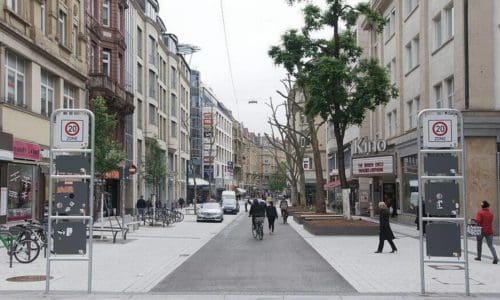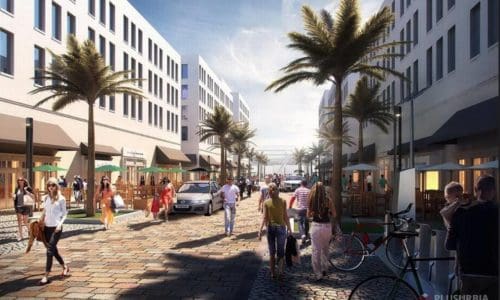
A woonerf, or shared street, in Stuttgart, Germany. Photo credit: Mussklprozz/Wikimedia Commons
Some time in the very near future, Wynwood will get something quite avant-forward, at least for Miami: A street in which cars, bikes and pedestrians share the pavement on an equal footing.
It’s called a “woonerf,” it’s inspired by the Dutch, and it’s coming to four blocks in the heart of Wynwood. On Thursday, Miami commissioners approved a contract with a Brooklyn, N.Y., firm that will design the city’s first true shared street.
In a woonerf (pronounced voo-nerf), planters, landscaping and bollards serve to slow down motorists enough so that people on foot and in cars or on bikes can mix freely and safely.
For the formerly industrial Wynwood district, now a flowering arts and entertainment mecca, the woonerf affords an opportunity for badly needed green and welcoming public space. It would also provide a secondary focus for its lively street life west of the neighborhood’s main drag, Northwest Second Avenue.
The idea is to transform the scruffy Northwest Third Avenue right-of-way between Northwest 29th Street, the district’s northern border, and 25th Street, where the street dead-ends, providing a natural terminus for the woonerf. The street is today distinguished largely by the Wynwood Building, the warehouse prominently painted in a zebra-stripe design.

The zebra-striped Wynwood Building sits on Northwest Third Avenue, which will be transformed into a “woonerf,” a street in which cars, bikes and pedestrians share the pavement on an equal footing. Photo credit: Ger Ger – Getty Images
But can the woonerf concept stand up to the belligerent carelessness of so many Miami motorists? Experts say the devil is in the design details, but woonerfs have proven themselves all over the world, and are increasingly popping up in U.S. cities.
It does require care and alertness by all users, but that’s why the woonerf works, they say. Beyond some basic principles, their design can be tailored to local circumstances.
“There’s no real guidelines for what a woonerf needs to be, so you can be creative,” said Juan Mullerat, principal at Coconut Grove-based urban design firm PlusUrbia, which first came up with the idea for a Wynwood woonerf when it drew up a new zoning plan for the burgeoning hipster district. “The idea is slow cars down and provide an equal use of the street.”
For the Wynwood blueprint, the city is turning to Local Office Landscape and Urban Design, whose co-principal, architect Walter Meyer, grew up in Miami. The firm won a competition for the $392,900 design contract.
Separately, the commission also approved a $615,140 contract with Miami-based Arquitectonica GEO for a broader tree and landscape master plan for Wynwood, a former warehouse district sorely lacking in greenery.
Local Office, which designed the temporary Grand Central Park in downtown Miami, also collaborated on the design for the recently completed makeover of Miracle Mile and a block of adjacent Giralda Avenue in Coral Gables.
Giralda, the suburban city’s famed restaurant row, was redesigned in a woonerf-like fashion, with no curbs or sidewalks and trees planted in the center of the street. But the city has closed it off to cars in a two-year experiment, turning it into a pedestrian plaza filled with outdoor cafe and restaurant tables.

The recently remade restaurant row in Coral Gables, Giralda Plaza, was designed as a shared street but is functioning as a car-free pedestrian plaza in a two-year experiment. Photo credit: City of Coral Gables
This modern version of the shared street originated in the Netherlands in the 1970s, thus the Dutch name. It has spread around the world, though the concept of people on foot mixing it up with horses, carriages, bicyclists, trolleys and, yes, even motorcars is an old one.
Before urban streets were segregated for use primarily by cars, with pedestrians relegated to sidewalks, different modes of transportation mixed in freewheeling fashion in cities across the world and in the United States.
Modern woonerfs are intended to put the pedestrian first. They often have no signage and no curbs, to avoid tripping obstacles and to provide a feeling of expansive shared space. Often they contain cues such as colored pavement or bollards to demarcate primary areas for pedestrians and cars.

A rendering of a concept for a woonerf in a new pedestrian friendly zoning district in eastern Hialeah.
Photo credit: PlusUrbia
Because of Miami-Dade County road-safety rules, though, the Wynwood woonerf may have to provide separate primary zones for motor vehicles and pedestrians, perhaps through markings or signage, said Jorge Kuperman, an architect whose office sits on Giralda Plaza and who served on the steering committee for the makeover.
“We are the country of regulations, but it can be as minimal as landscaping,” Kuperman said. “It’s a great model, obviously. You can go to Lisbon or Madrid. All you see are urban interventions that are absolutely curbless. They are not from last year. They’re from long ago. And they’re designed mainly for the life of pedestrians.”
